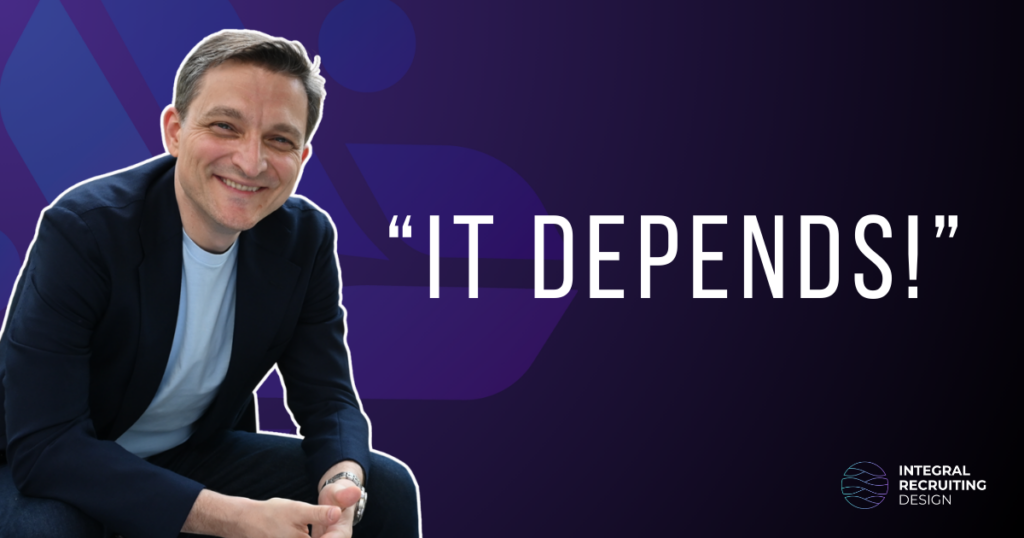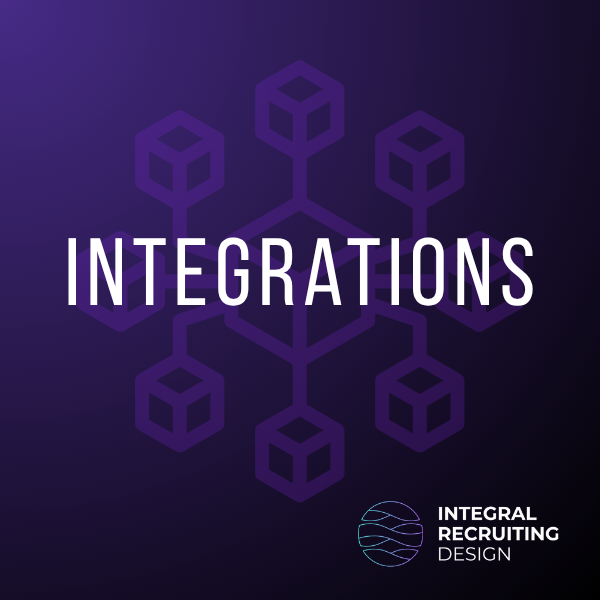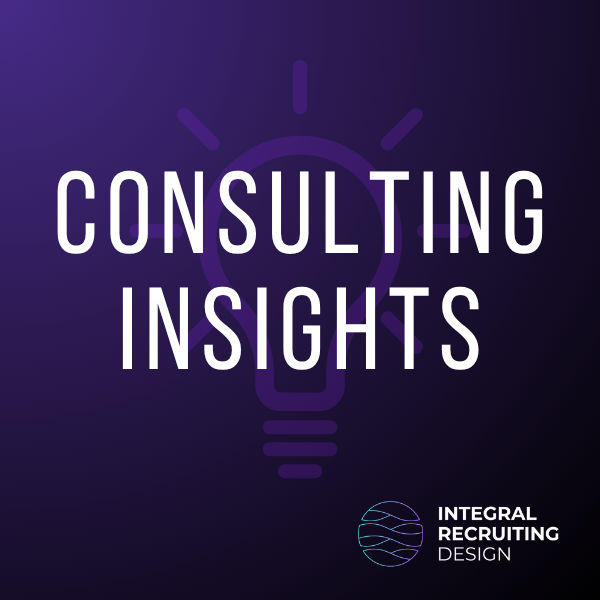There’s a running joke in the consulting world that the answer to every client question is, “It depends.”
It’s funny because it’s true—and it’s especially true in HR tech.
I can’t tell you how many times I’ve been asked, “What’s the best applicant tracking system?” In fact, it’s the very first thing people ask me at business mixers with HR leaders when I tell people, “I work in TA technology consulting.” That, or “Do I really need a full-time system administrator to run System X?”
And my answer is always the same: It depends.
That answer might sound evasive. But it’s actually the only responsible way to respond to high-stakes questions about software that governs people, processes, data, and dollars. The right solution for a 100-person startup with rapid growth plans looks vastly different from what a 10,000-person multinational needs.
In this article, I’m going to unpack the three most common areas where people crave a definitive answer—and why the truth always lives in the details:
- ATS Vendor Selection
- System Administration
- Artificial Intelligence
ATS Vendor Selection
There is no single “best” applicant tracking system. There is only the best system for you, based on your size, your global footprint, and the maturity of your talent function.
At the very beginning of a company’s life, you don’t even post jobs. You hire from your network. Then you move to spreadsheets. Then a basic ATS. Then a slightly better one. And eventually—if your growth justifies it—you’ll need an enterprise-grade system.
That’s the natural progression. But the right choice at any given moment? It depends.
It depends on how many people you’re hiring, how complex your workflows are, how global your operations are, and how sophisticated your reporting needs are.
System Maturity Matches Company Maturity
I often see companies trying to leapfrog this natural progression—jumping straight to enterprise solutions before they have the infrastructure, processes, or personnel to support them. It’s like giving a Formula 1 car to someone who just got their learner’s permit. The power is there, but without the skills to harness it, you’re more likely to crash than to win races.
A seed-stage startup might be perfectly served by a lightweight, easy-to-use system. As you scale toward 500 employees with more specialized hiring workflows, you may need a platform that offers more configurability and structured automation. And once you’re pushing past 1,000 employees—with global operations, specialized divisions, and complex compliance needs—enterprise-grade platforms become a more reasonable investment.
The costs scale accordingly too—from a few thousand dollars annually to six or seven figures. And that doesn’t include implementation, training, or ongoing maintenance. Is the premium price tag worth it?
It depends on what problems you’re solving and what capabilities you’ll actually use.
The Best-of-Breed vs. One-Stop-Shop Dilemma
There’s also the ever-present debate: one-stop-shop vs. best-of-breed. Should you buy your ATS from your HCM vendor, or go with a purpose-built solution?
That’s a whole article in itself, but the short version is: tacked-on ATS functionality will never match a point solution in depth or configurability. On the other hand, bundling may bring efficiency and cost savings—but that can come at the expense of flexibility. Which route should you take?
It depends.
I’ve seen companies implement Workday HCM and then struggle with Workday Recruiting because their talent acquisition processes were too specialized. I’ve also seen companies juggle five different recruiting technologies that don’t talk to each other, creating data silos and process inefficiencies. Neither extreme is ideal.
The key questions are: How much does your recruiting process differ from standard workflows? How important is seamless data flow between your HCM and ATS? And how much are you willing to compromise on specialized features for the sake of integration?
The Global Compliance Layer
And as your company scales globally, another layer emerges: compliance.
Regulations like GDPR, LGPD, and country-specific labor laws make compliance non-negotiable. Some systems simply aren’t built to handle that complexity. Robust platforms like iCIMS can, but they may be more than what a smaller company needs—or can manage.
I once worked with a US-based company expanding into Europe. They’d been using a basic ATS that served them well domestically. But when faced with GDPR requirements—right to be forgotten, data portability, consent management—they realized their system simply couldn’t adapt. They had two choices: upgrade to a more robust global system or implement a separate European instance with different processes.
The right answer?
It depends on their growth trajectory, budget constraints, and appetite for process complexity. They ultimately chose a hybrid approach: upgrading their primary system while maintaining a separate European instance during the transition—not ideal, but pragmatic given their circumstances.
System Administration – Do You Really Need a Full-Time Admin?
This is a common pain point, especially for companies in that gray area—too complex for smaller solutions, but not quite ready to fully staff a systems team.
I often see this with companies around the 1,000-employee mark. They buy an enterprise-grade ATS to prepare for growth—only to discover just how much time, attention, and skill it takes to run. Suddenly, the system feels like overkill.
Is it?
It depends.
If you’re growing fast and anticipate doubling or tripling headcount in the next few years, that investment may be wise—provided you also invest in the people needed to make it work. But if you’re stable at 1,000 employees and not planning major expansion, the same system might feel over-engineered and too difficult to maintain.
System Administration Is a Real Profession
This is where many teams make a critical error: they underestimate the profession of system administration.
A recruiter with great spreadsheet skills is not necessarily a system admin. And while, yes, sometimes it works out (it did for me—I became an iCIMS admin simply because I had the aptitude and the curiosity), that’s not a scalable or repeatable strategy. When I left, the team had no one to fill the gap. They eventually abandoned the platform—not because it was bad, but because it wasn’t the right fit without the right talent behind it.
The reality is that enterprise HR systems require specialized knowledge that goes far beyond basic user skills. A good system admin doesn’t just “keep the lights on”—they’re constantly optimizing, troubleshooting, and evolving the system to meet changing business needs. They need to understand:
- The technical architecture of the platform
- API integrations and data flows
- Security protocols and user permissions
- Workflow configuration and automation
- Reporting capabilities and limitations
- Change management and user adoption strategies
That’s a significant skill set. And it’s often undervalued until the system starts breaking down or users revolt because their needs aren’t being met.
Different Administration Models for Different Needs
System administration can be:
- Half a job
- A full-time job
- A distributed responsibility across geographies
- A team of specialists with distinct roles
What’s right for your team?
You guessed it—it depends.
It depends on your system’s complexity, the number of users, the volume of change requests, your internal processes, and how much you value proactive optimization versus reactive troubleshooting.
At smaller companies with moderate hiring volume, it’s not uncommon for system administration to be handled part-time by a technically inclined recruiter or coordinator. Sometimes it even falls to a TA Manager who enjoys tinkering with the system. But while that can work for a while, it’s ultimately a distraction from their core responsibilities. And there always comes a tipping point—usually when you’re managing multiple integrations, coordinating complex workflows across departments, or supporting users in different business units—where this compromise approach starts to break down.
At smaller companies with moderate hiring volume, it’s not uncommon for system administration to be handled part-time by a technically inclined recruiter or coordinator. Sometimes it even falls to a TA Manager who enjoys tinkering with the system. But while that can work for a while, it’s ultimately a distraction from their core responsibilities.
There’s a tipping point—usually when you’re managing multiple integrations, coordinating complex workflows across departments, or supporting users in different business units—where this ad hoc approach starts to break down.
One of the first things we look for during an ATS Health Check is the number of User Admins in the system. We have a running joke internally, Oprah-style: “You’re an Admin! And YOU’RE an Admin!” It’s surprisingly common—and almost always a red flag.
I worked with one company that tried to distribute admin responsibilities across their entire recruiting team. Each person was empowered to make changes in the system. It seemed clever on paper: no single point of failure, built-in cross-training, no need for a dedicated headcount. But six months in, they were dealing with inconsistent configurations, conflicting changes, and a system that was less stable than when they started. Eventually, they hired a dedicated admin—and saw immediate improvements in system performance, data integrity, and user satisfaction.
The Cost of Underinvestment
The financial math seems simple: a full-time system admin salary vs. the cost of the platform. If the admin costs 30% of your annual license fee, is that worth it?
Again, it depends—but I’d argue that’s the wrong calculation. The real question is: what’s the cost of system failure? What happens when:
- Candidates can’t apply because a form is broken
- Hiring managers can’t schedule interviews because the integration failed
- Leadership can’t get accurate hiring metrics for the board meeting
- Compliance documentation is incomplete or inaccessible during an audit
These failures have real costs—in lost talent, productivity, credibility, and sometimes even legal exposure. A good system admin prevents these failures before they happen. They’re not just a cost center; they’re insurance against much larger potential losses.
AI Adoption – Play Before You Procure
When it comes to AI, the question isn’t whether to use it. It’s how.
Most leaders already know AI is non-negotiable. It’s not a matter of if it will affect your organization—it already is. The real questions are when to introduce it, where it fits best, and how to ensure it creates value without introducing unnecessary risk.
But what I see, again and again, is hesitation—rooted not in strategy, but in personal comfort levels.
Should you adopt AI tools?
Of course. But the right tools, at the right time, for the right reasons?
It depends.
And it especially depends on your own readiness as a leader.
The Personal Comfort Gap
Many executives haven’t had the space—or support—to explore AI in a low-stakes way. They’ve read the articles. They know the talking points. But like analytics before it, AI becomes window dressing when it’s not grounded in understanding. Dashboards and demo videos won’t give you the fluency you need to guide your team.
I say this with deep empathy. Even working in tech, I have gone through periods of overwhelm, avoidance, and re-engagement. It’s a process. And that’s okay.
But here’s what I’ve learned: if you want to lead AI adoption in your company, you have to play with it yourself. Personally. Not to master it, but to get comfortable enough to recognize what’s real, what’s risky, and what’s hype.
Start with something practical—like your everyday writing. I’ve found immense value in having AI help refine my communication, especially when emotions are running high. There have been countless times when getting an AI perspective on an email drafted in frustration saved me from a regrettable send.
Balance the work with play. Try generating images for your next presentation. Design a mock brand refresh. Create personalized content for team celebrations. These low-stakes experiments aren’t just fun—they’re teaching you the art of effective prompting, which is quietly becoming an essential leadership skill.
Just remember to pace yourself. The AI landscape evolves weekly, and even dedicated professionals struggle to keep up. Give yourself permission to explore, step back, and absorb before diving in again. Learning new technology requires its own form of emotional labor—alternating between curiosity and frustration, excitement and overwhelm.
That comfort will sharpen your judgment. It will allow you to challenge vendors who are just layering AI into their products without thinking through implications. You’ll be able to ask better questions and smell when a company is failing to move at the speed of trust.
Start Small but Start Somewhere
The most successful AI adoptions I’ve seen start with modest, high-impact use cases:
- Resume screening and candidate matching to reduce initial screening time
- Interview question generation based on job requirements
- Candidate communication templates that adapt to different roles and stages
- Basic insights derived from your existing recruiting data
These aren’t revolutionary. They won’t transform your entire talent acquisition process overnight. But they provide tangible value while building organizational comfort with AI capabilities.
I worked with a talent acquisition leader who was deeply skeptical of AI tools. We started with a simple experiment: using AI to draft initial screening questions based on job descriptions. The team could review, modify, or reject the suggestions. After three months, they found they were consistently using about 70% of the AI-generated questions with minimal edits. The time savings were modest—maybe 15 minutes per role—but across hundreds of openings, it added up. More importantly, it built confidence in the technology’s potential while maintaining human oversight.
The Ethics Question Is Non-Negotiable
As you adopt AI, you’ll face legitimate questions about bias, privacy, and candidate experience:
- How do we ensure our AI tools don’t amplify existing biases in our hiring data?
- What happens to candidate data processed through these systems?
- How transparent should we be with candidates about AI’s role in the hiring process?
- What human oversight is necessary at different stages?
These questions don’t have universal answers—they depend on your company’s values, risk tolerance, and candidate expectations. But they must be addressed explicitly, not as an afterthought.
I’ve seen companies rush to implement AI screening tools without considering how those tools might interact with their DEI initiatives. Others have adopted chatbots without clear protocols for when to escalate to human interaction. The technology worked as designed, but the human framework around it was insufficient.
What’s the best way to build AI into your org?
It depends—on your culture, your systems, your risk appetite, your workflows, and most of all, your leadership’s willingness to engage.
The Real Answer Is Always Context
So—what’s the best ATS? Do you need a full-time system admin? Should you be investing in AI?
You know the answer by now: it depends.
On your context. Your goals. Your people. Your timeline. Your appetite for complexity and your capacity for change.
“It depends” isn’t a dodge. It’s a compass. It points you toward deeper thinking, clearer criteria, and smarter decisions—not just about technology, but about the future you’re trying to build.
The most valuable conversations I have with clients don’t start with solutions. They start with questions:
- What are you optimizing for? Speed? Quality? Compliance? Cost?
- Where are you today, and where do you need to be in 12, 24, or 36 months?
- What’s your tolerance for process change alongside technology change?
- How much resource capacity do you have to support new systems?
- What’s worked and what’s failed in your previous technology implementations?
These questions reveal the context that shapes the right answer for your organization. They transform “it depends” from a frustrating non-answer into the beginning of a strategic conversation.
And that conversation—the one that embraces complexity rather than hiding from it—is where the real value lies. Not in the silver-bullet solution that promises to solve everything, but in the thoughtful matching of tools, processes, and people to your specific challenges and opportunities.
Because in HR tech, as in life, the honest answer is rarely simple. But it’s always worth finding.





